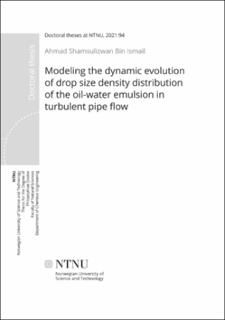| dc.contributor.advisor | Grimes, Brian A. | |
| dc.contributor.advisor | Jakobsen, Hugo Atle | |
| dc.contributor.author | Ismail, Ahmad Shamsulizwan Bin | |
| dc.date.accessioned | 2021-03-16T10:12:36Z | |
| dc.date.available | 2021-03-16T10:12:36Z | |
| dc.date.issued | 2021 | |
| dc.identifier.isbn | 978-82-326-5403-1 | |
| dc.identifier.issn | 2703-8084 | |
| dc.identifier.uri | https://hdl.handle.net/11250/2733581 | |
| dc.description.abstract | The thesis presents a modelling approach to calculate and fit the evolution of the drop size distributions of oil and water emulsions under turbulent flow in pipes. A simulation model is developed to investigate coalescence and breakage phenomena of droplets in liquid-liquid dispersion over a long-distance pipeline under a fully dispersed flow regime and compared to experimental data (validation) to fit the model parameters. The mathematical model employed the population balance equation (PBE) approach to predict the volume and number density distribution functions, mean radii, standard deviations as well as breakage and coalescence rates over various distances in pipes. The thesis concerns the difficult and complex task of turbulent flow of multiphase mixtures in pipes, which is theoretically highly demanding and practically very important. The PBE-strategy used in the numerical solutions gives complete information not only about the flow fields of the phases, but also about the particle size distribution in the dispersed phase. An alternative solution to the complex PBE in the form of volume density distribution has been introduced using orthogonal collocation method for the case of fully developed turbulent oil-water pipe flow. Several breakage and coalescence models are assessed and compared to understand the behavior of the model. In addition, the model is also studied under various parametric effects together with minor modifications on the coalescence and breakage closures to account for high dispersed phase fraction. The results showed that the model has successfully fitted the model proportionality constants accordingly at the final measurement locations (in good agreement with experimental data at final location). | en_US |
| dc.language.iso | eng | en_US |
| dc.publisher | NTNU | en_US |
| dc.relation.ispartofseries | Doctoral theses at NTNU;2021:94 | |
| dc.relation.haspart | Regression of Experimental Pipe Flow Data with Population Balance Modelling. Part
I: Model formulations and solutions | |
| dc.relation.haspart | Regression of Experimental Pipe Flow Data with Population Balance Modelling.
Part II: Parametric Effects and Model Behaviour | |
| dc.relation.haspart | Regression of Experimental Pipe Flow Data with Population Balance Modelling. Part
III: Comparison to experimental of oil-water emulsions in turbulent pipe flow | |
| dc.title | Modeling the dynamic evolution of drop size density distribution of the oil-water emulsion in turbulent pipe flow | en_US |
| dc.type | Doctoral thesis | en_US |
| dc.subject.nsi | VDP::Technology: 500::Chemical engineering: 560 | en_US |
| dc.description.localcode | digital fulltext is not available | en_US |

